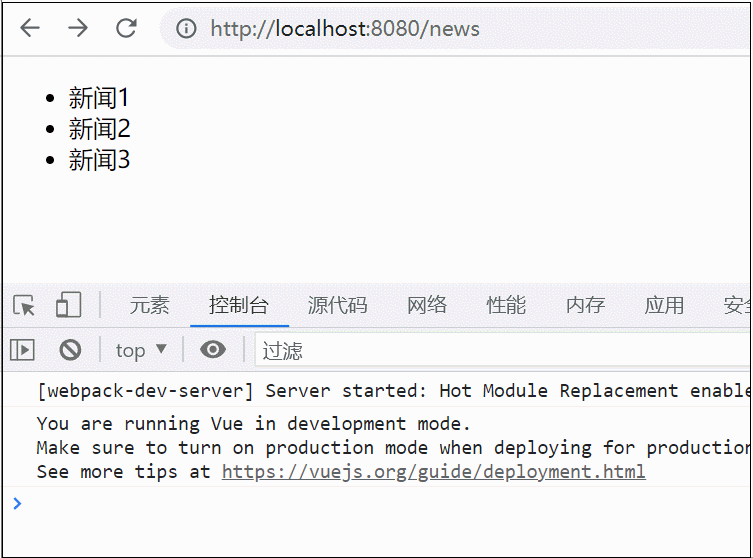生活没有真正的完美,只有不完美才是最真实的美;生活没有一帆风顺的,只有披荆斩棘才能路路顺;生活没有永远的成功,只有在挫折中站起才是真正的成功,只有闪光的人生才算是生命的永恒。
一.父子组件传值
<!DOCTYPE html>
<html lang="en">
<head>
<meta charset="UTF-8">
<title>父子组件传值</title>
<style>
</style>
<script src="./vue.js"></script>
</head>
<body>
<div id="root">
<counter :count="0" @numberchange="handleChange"></counter>
<counter :count="0" @numberchange="handleChange"></counter>
<div>{{total}}</div>
<validate-content content="hello world"></validate-content>
</div>
<script>
//父组件向子组件传值用 props ,加:号后传递的为js表达式,示例中则为数字,不加:号代表的是字符串
var counter = { //局部注册
props:['count'],
data:function(){//在子组件中定义数据,data不能是对象,必须是一个函数。
return {
number:this.count
}
},
template:'<div @click="handleClick2">{{number}}</div>',
methods:{
handleClick2:function(){
this.number ++;
//this.count++; 父组件可以传值给子组件,但子组件不可以修改父组件属性,这里这么写会报错。
this.$emit("numberchange",this.number);//子组件向父组件传递事件,值
}
}
}
var validateContent = {
props:{
//content:[Number,String] //组件参数校验,可以多选
content:{//组件参数校验
type:String,
required:true,
default:"default value",
validator:function(value){
return value.length > 5
}
}
},
template:'<div >{{content}}</div>',
}
var vm = new Vue({
el:'#root',
data:{
total:0
},
methods:{
handleChange:function(number){
console.log(number)
// this.total +=1;
}
},
components:{
counter, //局部注册要在根节点注册组件
validateContent
}
})
</script>
</body>
</html>
二.父组件向子组件传递DOM
先看一个示例
<body>
<div id="root">
<child><p>Qin</p></child>
</div>
<script>
let child = {
template :`<div>
<p>hello world</p>
</div>`
}
var vm = new Vue({
el:'#root',
components:{
child
}
})
</script>
</body>
打开查看器查看一下
发现Qin不见了
<p>Qin</p>1
查看官方文档 , https://cn.vuejs.org/v2/guide/components-slots.html
我们得出结论:如果 child 没有包含一个 < slot > 元素,则任何传入它的内容都会被抛弃
我们加入插槽
<body>
<div id="root">
<child><p>Qin</p></child>
</div>
<script>
let child = {
template :`<div>
<p>hello world</p>
<slot></slot>
</div>`
}
var vm = new Vue({
el:'#root',
components:{
child
}
})
</script>
</body>
发现Qin能正常显示,且slot将会被替换为解析后的片段 < p > Qin < /p >
当父组件不向子组件传值的时候,slot还可以作为父组件默认值出现
<body>
<div id="root">
<child></child>
</div>
<script>
let child = {
template :`<div>
<p>hello world</p>
<slot>default value</slot>
</div>`
}
var vm = new Vue({
el:'#root',
components:{
child
}
})
</script>
</body>
效果图
具名插槽
如果想使用多个插槽,我们先看看效果:
<body>
<div id="root">
<child>
<header>This is header</header>
<footer>This is footer</footer>
</child>
</div>
<script>
let child = {
template :
`<div>
<slot></slot>
<p>Main content</p>
<slot></slot>
</div>`
}
var vm = new Vue({
el:'#root',
components:{
child
}
})
</script>
</body>
发现出现了多个header和footer,要解决这个问题就要用到具名插槽
我们修改代码如下:
<body>
<div id="root">
<child>
<header slot="header">This is header</header>
<footer slot="footer">This is footer</footer>
</child>
</div>
<script>
let child = {
template :
`<div>
<slot name="header"></slot>
<p>Main content</p>
<slot name="footer"></slot>
</div>`
}
var vm = new Vue({
el:'#root',
components:{
child
}
})
</script>
</body>
可以看到显示正常了
总结
以上所述是小编给大家介绍的vue中父子组件注意事项,传值及slot应用技巧,希望对大家有所帮助,如果大家有任何疑问请给我留言,小编会及时回复大家的。在此也非常感谢大家对网站的支持!
到此这篇关于vue中父子组件注意事项,传值及slot应用技巧就介绍到这了。一个人有生就有死,但只要你活着,就要以最好的方式活下去。更多相关vue中父子组件注意事项,传值及slot应用技巧内容请查看相关栏目,小编编辑不易,再次感谢大家的支持!

